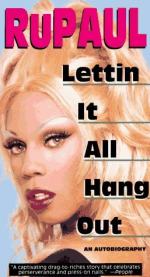|
This section contains 364 words (approx. 2 pages at 300 words per page) |
RuPaul Andre Charles was the first African-American, disco-loving drag queen to secure a contract with a major cosmetics company (M.A.C., 1995). RuPaul was a stunning beauty at six-feet-seven-inches in heels and propagated an ethic of self-love, acceptance of others, finger-wagging questioning of convention, and self-promotion not seen since Andy Warhol.
 RuPaul (left) with Joan Rivers.
RuPaul (left) with Joan Rivers.
A fixture of the fashion and dance club scene in New York City beginning in the late 1980s, RuPaul became a household name when his 1993 debut album, Supermodel of the World, earned three #1 Billboard hits and received heavy airplay on cable music video channels and radio stations. In 1994 RuPaul teamed with Elton John to record "Don't Go Breaking My Heart" for John's Duets album. RuPaul hosted a morning drive-time show on New York City's top-rated WKTU-FM (1996-97), several cable television specials, and a talk show on cable's VH1 music video channel (1997-98). Addressing fashion, music, and current news issues, The RuPaul Show was a half hour of glitz, glamour, and infectious self-affirmation.
Between 1994 and 1998 RuPaul appeared in eleven films, sometimes in drag, sometimes not. His roles in The Brady Bunch Movie (1995) and A Very Brady Sequel (1996) aptly combined his neo-disco style with the retro-chic, tongue-in-cheek revival of the Brady franchise for a bit of cultural nostalgia that was very successful commercially.
RuPaul was forthcoming about his status as a cross-dresser and even used it as a marketing ploy with M.A.C. cosmetics: "If M.A.C. products can make a big old black man like me look this good," he was known to say, "just think of what they can do for you, girl." As co-chair of M.A.C.'s AIDS fund, RuPaul helped raise several million dollars between 1995 and 1997. His fundraising prowess and altruism notwithstanding, RuPaul attracted the criticism of religious leaders worldwide who denounced the use of a drag artist as a spokesperson for an otherwise reputable company and cause.
Further Reading:
M.A.C. Press release. November 6, 1997.http://www.RuPaul.net. February 1999.
Romanowski, Patricia, et al., eds. The New Rolling Stone Encyclopedia of Rock & Roll. New York, Rolling Stone Press, 1995.
RuPaul. Letting it All Hang Out. New York, Hyperion, 1995.
|
This section contains 364 words (approx. 2 pages at 300 words per page) |


